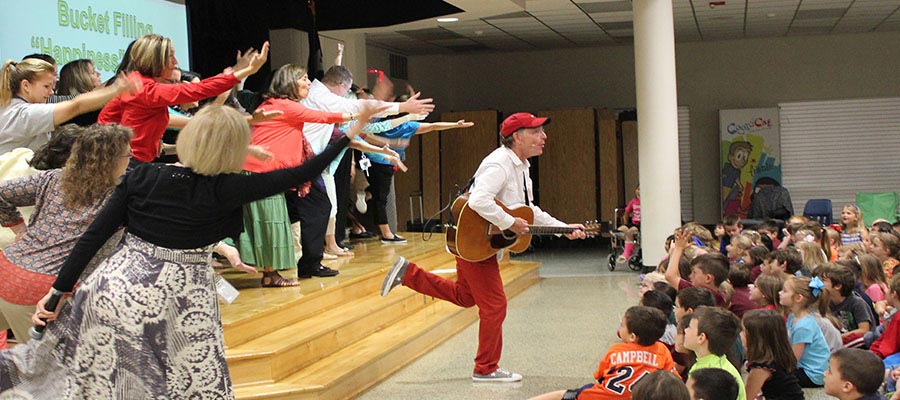Materials Needed
1. One striped sock per student. Anklet to knee sock size works best. Booties or Footie Socks (socks that don't go past your heels) won’t work. We used black/gold stripes but using any colors for stripes makes for a more unique bee. We were able to find lots of striped socks in dollar stores. Often times the socks were 2 pair for a dollar.
2. One 12 inch pipe cleaner per student. We used black but feel free to be creative when it comes to color.
3. Two eyes per student. We used eyes that were ¾ inch in diameter.
4. Three Styrofoam semi-circles (with a 2 ½ inch diameter) per student.
5. Pattern for wings (see attached image).
6. Material to make wings.You can use construction paper, fun foam, stiff felt, or transparencies used from an overhead projector.
7. The song, Bebop Your Best from Red Grammer's recording, Bebop Your Best.
8. Glue, markers, scissors.
Activity
1. Play the song, Bebop Your Best and have students listen to the lyrics. Play the song again and this time have students sing the part “Be-bop your best” along with Red. You can give the students any kind of hand movement to use while singing the words “Bebop your Best”.
1. Have a discussion about what it means to “Bebop Your Best”.
2. Have students volunteer at what they are good at doing. Have students think about what they would like to work on being good at in the classroom for this year. It could be learning to tie their shoe or working on a character trait like being respectful.
3. Have students make a “Bee” bop (see instructions and image below).
4. Play the song again and the students can move their bee while singing the words “Bebop your Best”
5. Students can leave the bees on their desks as reminders or you can hang them on a bulletin board.
6. The bee could be a talisman for the students.
Make the Bee
NOTE: An image of the bee and an image of the wing pattern are at the bottom of this lesson.
1. Have students place the 3 Styrofoam semi-circles inside the sock so they lay side by side and represent the head, thorax and abdomen of the bee.
2. Tie a knot at the end of the sock. This will keep the Styrofoam semi-circles in place and the knot represents the stinger.
3. Take a pipe cleaner and cut it in half. Have the student push the 2 pieces of pipe cleaner into the front on the head of the bee. Then have the students twist the open end of each pipe cleaner into a circle to form the ends of the antennae.
4. With the help of an adult have the students glue the eyes onto the head of the bee.
5. Have students trace the pattern for the wings and cut out the wings. With younger students have an adult help or have the wings cut out ahead of time.
6. Have the student (or the teacher) write on the left side of the wings what the student can “Bee” bop their best at. On the right side of the wings have the student write what they want to work on (“Bee” bopping their best) during the upcoming school year.
7. Using a blunt pointed object like a butter knife or scissors, push the middle of the wings (the part that connects the wings) through the sock and into the Styrofoam semi-circle that is in the middle of the sock (the semi-circle that represents the thorax of the bee).
Extension
1. Read a story about bees. Two good books are The Honey Bee by Paula Hogan and The Magic School Bus Inside the Bee Hive by Joanna Cole. Point out that honey bees are hard workers and bees work together to get the job done. As students in the classroom, they should be like bees working hard together to get the job done.
2. Using the bee that students made from this lesson, have them review the parts of the honey bee: abdomen, antennae, head, thorax, eye, stinger, wings. Note: We have not used legs or the pollen baskets on the bees made in this lesson. You could have the students say what body part is missing. You could also have the students add legs to their bees.
Images



